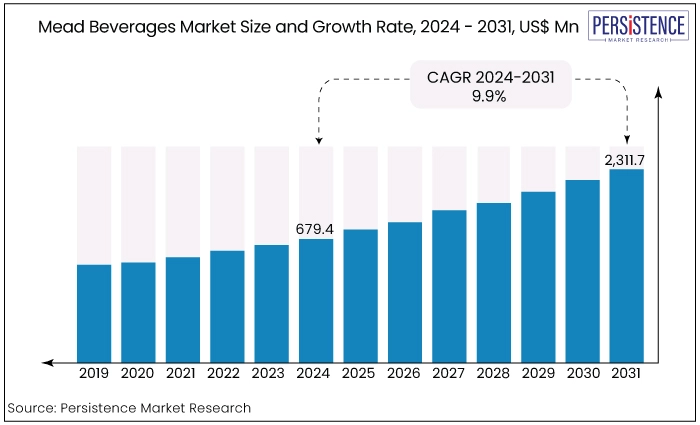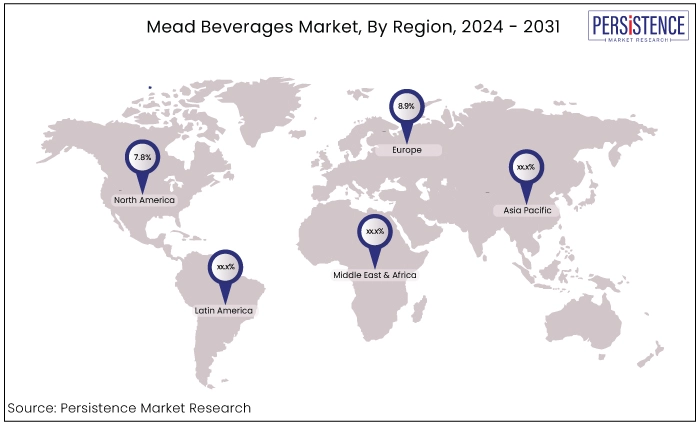Industry: Food and Beverages
Published Date: August-2024
Format: PPT*, PDF, EXCEL
Delivery Timelines: Contact Sales
Number of Pages: 160
Report ID: PMRREP34734
The global mead beverages market is estimated to value at US$2311.7 Mn by the end of 2031 from US$679.4 Mn recorded in 2024. The market is expected to secure a CAGR of 9.9% during the forecast period from 2024 to 2031.
Key Highlights of the Market
|
Market Attributes |
Key Insights |
|
Mead Beverages Market Size (2024E) |
US$679.4 Mn |
|
Projected Market Value (2031F) |
US$2,311.7 Mn |
|
Global Market Growth Rate (CAGR 2024 to 2031) |
9.9% |
|
Historical Market Growth Rate (CAGR 2019 to 2023) |
7.1% |

Mead has a long and illustrious history spanning thousands of years across numerous cultures. It is a beverage created from fermented honey, water, and occasionally extra components like fruits, spices, or grains.
Mead, once considered a specialty or historical oddity, is gradually making a comeback in the contemporary beverage scene, propelled by a growing consumer interest in unusual and traditional libations.
Its resurgence in the modern era is primarily attributable to the larger craft beverage movement, which has rekindled interest in drinks with enduring customs and handcrafted artistry. This comeback is a part of a broader trend in which buyers are looking for goods that are genuine, high-quality, and have a link to their history.
Mead is the ideal choice since it provides a drink with both a fascinating history and exciting future.Due to its varied taste profiles, long history, and compatibility with current health trends, mead is gaining ground in the beverage industry today. Mead's unique blend of innovation and history sets it up for long-term growth and success in the global marketplace, even as customer preferences continue to change.
|
Region |
CAGR through 2031 |
|
North America |
7.8% |
North America region is the most significant shareholder in the global market and is expected to expand at a CAGR of 7.8% during the forecast period. Several elements that foster the development and appeal of mead have combined to position North America to hold a sizable portion of the market for mead beverages.
Customers in the United States and Canada have demonstrated a strong appreciation for artisanal and small-batch products, contributing to the region's well-established craft beverage industry. Due to this, craft meaderies are growing at a rate similar to brewers, wineries, and distilleries. With its many flavour profiles and rich history, Mead is a fantastic fit for the region's open-minded consumer’s eager to try new and unusual beverages.
General accessibility and availability of mead is supported by North America's well-developed e-commerce sector and robust retail and distribution infrastructure for alcohol. The increasing availability of mead at restaurants, specialized liquor stores, and online marketplaces has simplified the process for customers to learn about and buy mead, adding to its expanding appeal.

|
Region |
CAGR through 2031 |
|
Europe |
8.9% |
Europe market is projected to secure a CAGR of 8.9% in the forecast period from 2024 to 2031.
Superior, artisanal beverages are highly valued in the European market, where consumers have sophisticated palates. This societal tendency toward handcraft has spurred the rise of specialized and boutique meaderies that concentrate on making high-quality, small-batch meads.
Many taste profiles that mead offers appeal primarily to customers in Europe. Meads that include fruit, herbs, and spices from the area are particularly well-liked, as they align with the region's emphasis on terroir and locally derived goods.
The market is expanding due to the increased appeal of mead festivals and other cultural events around Europe. These events provide a platform for educating customers and raising knowledge of mead, which frequently honours local heritage and traditional crafts. This increases demand for mead and helps to contribute to the significant growth in the European market.
|
Category |
Projected CAGR through 2031 |
|
Packaging Type – Bottle |
8.7% |
Premium drinks like wine, spirits, and mead are typically associated with bottles. Mead's relationship with quality and tradition improves its impression as a high-value product. It is essential to draw in discriminating customers prepared to spend more for an exceptional drinking experience.
Bottles provide meaderies with a flexible packaging solution that accommodates multiple sizes and shapes, enabling them to sell their goods in various amounts, ranging from single-serving sizes to bigger bottles meant for sharing. Because of its adaptability to various consumer demands and situations, bottled mead is an excellent option for casual and connoisseur drinkers.
|
Category |
Projected CAGR through 2031 |
|
Flavor - Fruit |
9.3% |
Fruit infusion gives mead a flavour profile that is adaptable and pleasing to various palates. Some customers might not enjoy traditional mead because of its strong honey basis, especially those who would instead drink lighter, fruitier libations.
Producers can provide an excellent option to attract new and returning customers by adding fruits like berries, citrus, and tropical types. This adaptability broadens the appeal of fruit-flavored meads by enabling them to accommodate a range of taste preferences, from rich and nuanced to sour and sweet.
Natural fruits, which are frequently obtained locally or organically, are used because they bring perceived health benefits and authenticity, which are highly prized in today's market. Moreover, adding fruits can improve the mead's nutritional profile by including vitamins, antioxidants, and other advantageous ingredients that appeal to health-conscious consumers.
The rise in popularity of mead, an alcoholic beverage made from honey, among individuals looking for distinctive, naturally sourced products was a major factor in the growing consumer interest in craft and artisanal beverages.
The popularity of mead, which is frequently seen as a cleaner alternative to conventional beer and wine, was also aided by the larger movement towards healthier and more natural components in alcoholic beverages.
Mead producers were able to experiment with new types, such fruit-infused or spiced meads, which attracted a diverse spectrum of consumers. This was made possible by the advent of the craft beverage movement, which championed small-scale manufacturing and novel flavours.
Geographic restrictions were overcome by mead producers through the growth of distribution methods, primarily through Internet platforms, which allowed them to access a global audience.
The growing number of mead tastings, craft beer festivals, and educational activities will offer customer interaction opportunities, raise awareness, and promote category loyalty. Mead may be positioned as a high-end product that appeals to customers looking for sophisticated and exclusive drinking experiences.
Increasing Consumer Interest in Craft and Specialty Beverages
Consumers gravitate toward artisanal and small-batch products over mass-produced ones as they want more distinctive and customized drinking experiences. This tendency is especially noticeable in the mead industry as consumers seeking something different from traditional alcoholic beverages that are drawn to the beverage's rich history and flavour characteristics.
Craft meaderies are taking advantage of this demand and producing a wide range of mead style by experimenting with cutting-edge ingredients and production methods. The emergence of regional and community-based beverage marketplaces has strengthened the bond between producers and consumers, which has improved mead's appeal as a specialty product.
New and Unique Flavour Profiles Attract Diverse Consumer Segments
Consumers' demand for customized and distinctive drinking experiences has increased as expectations and preferences have changed. With a wide variety of flavour profiles to suit a wide range of palates, mead has benefited from the trend of consumers looking for unique and innovative products in this day and age.
A wide variety of fruits, spices, herbs, and even vegetables are now being added to meads by manufacturers, who are no longer limited to using only conventional formulas. Different palates will find something to like in the meads produced from this experimentation, which range from fruity and flowery to peppery and savoury.
Meads with exotic fruit flavours, like passion fruit or mango, appeal to consumers seeking a tropical twist, while those with spice characteristics, like ginger or cinnamon, suit people who like stronger, more nuanced tastes.
The artisan beverage movement has greatly aided the development of innovative mead flavour profiles. Also, producers of mead have taken a similar tack, drawing attention to their products' unique qualities and inventiveness to set them apart from the competition.
Lack of Familiarity with Mead Compared to Established Beverages
Unlike more popular alcoholic beverages like beer, wine, and spirits, mead is still relatively unknown in modern consumer markets despite its long history and significance. Several obstacles to the mead industry's growth and market penetration stem from this lack of knowledge. A key problem arising from this unfamiliarity is reluctance on the part of customers.
Many people hesitate to test new products, especially if they have developed preferences for well-known drinks. People must learn what to expect regarding flavour, quality, or experience because mead has not been widely exposed to the public. In contrast to wine or beer, which are well-known and have a significant cultural following, mead needs a well-accepted story that appeals to most consumers.
Mead finds it more challenging to draw in new clients who might be hesitant to try anything new or step beyond their comfort zones because of this misunderstanding.
Development of Low-Sugar and Probiotic Meads
A growing number of individuals are reassessing their eating habits, especially their use of processed foods and sugar, as knowledge of health and wellness increases globally. This change presents a rare opportunity for meaderies to get creative and seize a market segment increasingly interested in health-conscious options.
The general worry over sugar consumption and its connection to several health problems such as obesity, diabetes, and cardiovascular diseases is one of the main factors making low-sugar meads an appealing business prospect.
Probiotic integration into mead production is also a growing possibility that corresponds with consumers' interest in functional foods and drinks. Due to increased consumer awareness of the value of preserving a healthy digestive system, probiotics are well known for their effects in improving gut health.
Growth in Mead Tasting Events, Festivals, and Meadery
The rise in meadery tours, festivals, and sampling events offers a sizable market opportunity and a potent means of boosting customer engagement and propelling market expansion in the industry. These experiential marketing techniques are becoming increasingly crucial in the beverage sector as customers look for unique experiences that strengthen their bonds with their favorite brands.
Mead festivals expand on this idea by bringing together a range of meaderies, frequently from several locations, to highlight their goods to a broader public. Usually vibrant, social gatherings, these festivals draw both meaderies and non-fans. In addition to tastings, they frequently include food pairings, live music, and instructive courses, all contributing to the celebratory mood and bringing sizable crowds.
Branding and marketing are essential in the mead market's highly competitive environment.
Since mead is still more of a niche product than other alcoholic beverages, drawing and keeping customers requires strong branding.
Producers are investing in eye-catching packaging, imaginative label designs, and captivating brand narratives that accentuate their goods' distinctive features and historical significance.
Many meaderies also use digital marketing and social media to interact with customers directly, telling their mead stories and creating a community among drinkers.
|
Attributes |
Details |
|
Forecast Period |
2024 to 2031 |
|
Historical Data Available for |
2019 to 2023 |
|
Market Analysis |
US$ Million for Value |
|
Key Regions Covered |
|
|
Key Market Segments Covered |
|
|
Key Companies Profiled in the Report |
|
|
Report Coverage |
|
|
Customization & Pricing |
Available upon request |
By Flavor
By ABV
By Packaging Type
By Distribution Channel
By Region
To know more about delivery timeline for this report Contact Sales

The mead beverages market is estimated to be valued at US$2311.7 million by 2031.
Rising consumer interest in craft and artisanal products drives the market for mead beverages.
Bottles are expected to hold a significant share in the mead beverages market.
Developing probiotic and low-sugar meads could be lucrative in the mead beverage market.
North America accounts for a significant market share of mead beverages.